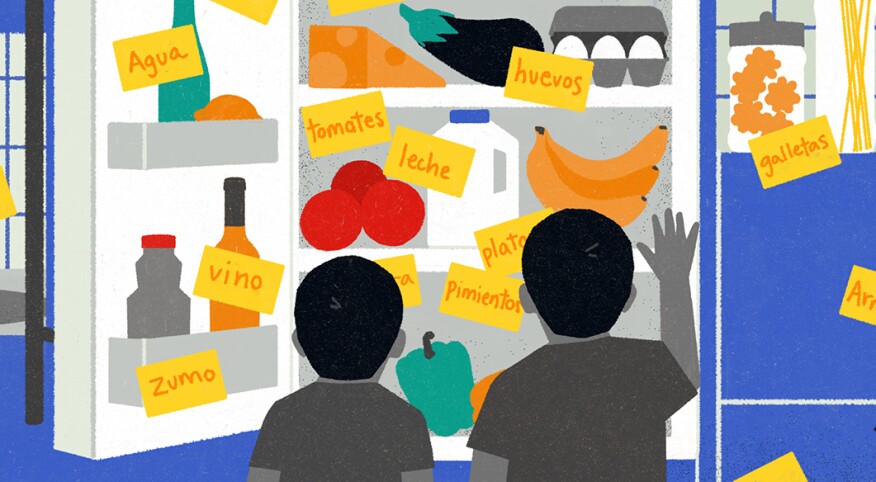During a last-minute trip to the grocery store, I rushed down the baking aisle and stopped a few feet past a woman and her young son. They exchanged a few words in Spanish. A minute later, his father rounded the corner and asked his son a question in English.
As a first-generation American — my mother is from Mexico — I recognized the verbal tennis match playing out next to me. Growing up, my mother communicated with us exclusively in Spanish, while my father spoke to us in English. Of course, I didn’t have a choice as to whether or not I learned Spanish. At the time, my mother wasn’t fluent in English. So naturally, I assumed my future children would enjoy learning Spanish from me. What I didn’t consider was how my determination to teach them a second language would dampen their desire to learn.
After our first child was born, my husband and I were looking forward to continuing the family language tradition, but his long hours meant my son wouldn’t learn English until he started school. Instead, I peppered Spanish words into our daily conversations the same way I sneaked pureed vegetables into his meals.
“Do you want leche?” I asked while I pointed to a carton of milk. Or “Let's jugar with el perro,” I suggested as I crouched next to the dog.
My sneaky method helped him learn a few words, but when pressed for time and eager to arrive at preschool on time, it was easier and more efficient for me to speak to him in English.
A year after my second son was born, my home-based business began to grow. I hired a part-time nanny — a former kindergarten teacher — to come to our house two days a week. She taught my youngest and his toddler brother a range of words and phrases in Spanish. She read books to them in her native language. She sang songs with them from her childhood. At the time, I didn’t recognize that she was combining teaching with playing. I had been focusing instead on the teaching element.
By the time my youngest entered preschool and the eldest kindergarten, they were able to understand a few phrases in Spanish. Still determined to increase their vocabulary, I printed Spanish words on 3-inch by 5-inch cards like little billboards and posted them on the refrigerator, the back door, their toy box, chairs and even in the bathroom. No room or surface was off-limits. Not only did I fool myself into thinking my brilliant, study-at-home program would work on both of my small geniuses, my house resembled the set of The Price is Right.
My subliminal methods to teach my sons to speak Spanish by the time they were in school full time seemed foolproof. They weren’t. Our dog destroyed a majority of the cards within a few months and with my sons in school all day, we no longer needed a nanny. I reverted to Spanglish, the one method I had managed to salvage. I thought I was being stealthy, but I wasn’t fooling anyone, especially my sons.
A few weeks after they started grade school full time, both joined forces: “Mom, we know what you’re doing,” my eldest said. “Please stop forcing us to learn Spanish.” I understood their frustration, but I couldn’t help feeling like the gourmet chef whose child prefers microwave meals.
I took sneaky off my list of strengths and left it up to my sons' teachers to share their Spanish skills with my children.
My sons thrived in their Spanish classes and discovered facts about their Colombian teacher’s hometown and the ways she celebrated various holidays. They finished their workbook pages and completed Spanish exercises on the computer. Disguised as games, they learned how to match objects to words, repeat phrases and pick the correct spelling of a word from a short list. They didn’t mind doing their Spanish homework. Eventually they were able to carry on conversations with my parents in Spanish when we visited them a few times a year. The boys enjoyed seeing the look of joy on their grandparents’ faces when they showed off their bilingual skills. I was proud of both of them.
Recently I asked a few friends with young children whether they were teaching their offspring another language. “Of course,” one said. “We have toys that switch between Spanish and English by pushing a button.” Another mom told me, “We’ve turned learning another language into a game.” Both parents encourage their children to use language apps on their iPads and to watch various videos in Spanish. Neither friend is bilingual. They don’t have the advantage I had of growing up speaking the language they wanted their children to learn. It doesn’t matter. What they do have is a desire to turn teaching their children a new language into a fun activity.
For years, I couldn’t understand why my sons wouldn’t want to learn Spanish through my scrappy, at-home language campaign. Finally, the answer was in front of me, but I was more focused on the outcome to notice. The more I encouraged — some may say pushed — my children to learn Spanish, the further they pulled away from the idea. They learned when they were ready.
My sons may not have been on board with my DIY home language campaign, but, technically, I did get my wish: Both have embraced a second language. One is conversational in Spanish, the other in Japanese.
Me? I'm still trying to figure out what to do with six boxes of blank 3-by-5 cards.

Maria Hergueta









